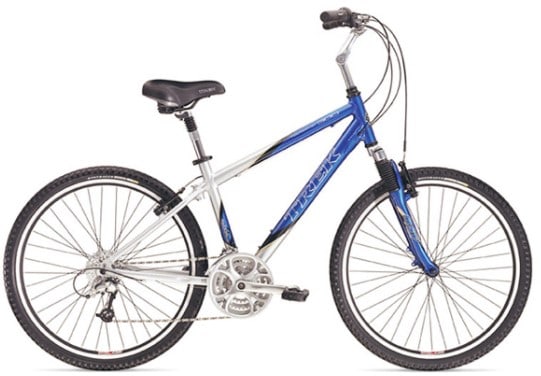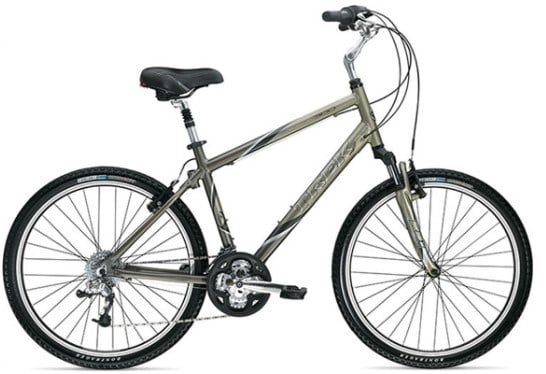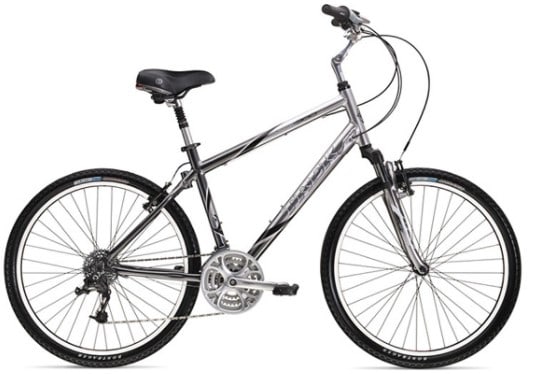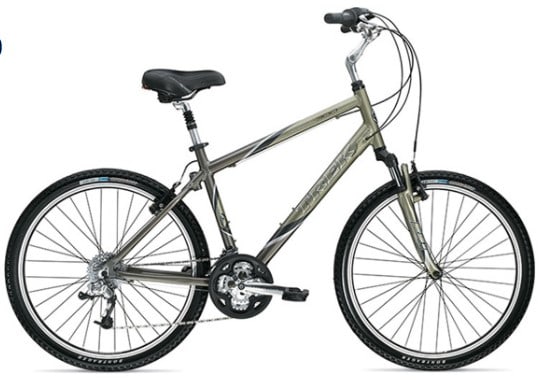It’s not often that you find a comfort bike with the toughness and versatility of an MTB. Luckily, the Trek Navigator 300 is one of those rare choices. So, this Trek Navigator 300 review will unpack this comfort bike’s best features and weigh them against their worst.
Generally, Trek Navigator 300 promises durable components and lots of comforts, living up to the title ‘comfort.’ It’s the kind of bike you can ride around town, run errands with, go to work with or cycle for fitness with.
So, have you been looking for an all-around comfort or hybrid bike for your everyday use?
Then the chances are that what you’ve been searching for is the Navigator 300. This review shall help you decide if that is the case.

Trek Navigator 300 Review – Table Summary
| Spec | Description |
| Bike Type | Comfort/hybrid bike |
| Frame | Alpha aluminum |
| Wheel Size | 26 x 1.95 inches |
| Cassette | SRAM 8-speed 8-32 |
| Speed | 8 Speed |
| Tires | Bontrager hard case |
| Brakes | Linear pull brakes |
| Fork | 50mm travel |
| Pedals | Dual-density platform pedals |
| Frame warranty | Lifetime warranty |
| Weight | 30-35 pounds |
| Generations | 8 |
About Trek Navigator 300
Trek Navigator 300 is a comfort bike (or hybrid bike) with many mountain bike specs. An adjustable headset, robust aluminum frame, suspension fork, and multi-surface tires are among them.
This bike was initially released in 1999 but discontinued in 2006 after eight generations.
Navigator 300 is generally a budget comfort bike, given that it cost under $500.
Plus, it’s relatively lightweight, averaging 30-35 pounds, depending on generation. Overall, the newest generations are lighter than the oldest generations.
But other than the weights, nothing much has changed over the years. Trek has maintained the design and the specs throughout.
Though Trek no longer makes the comfort bike, there is still a considerable stock size for those commuters who cannot afford high-end Trek hybrid bikes.

Trek Navigator 300 Specs
Though Navigator 300 is available in 8 generations, they all share these specifications:
1. Alpha Aluminum Frame
Trek’s Alpha aluminum frame technology produces aluminum frames that carbon frames can only match in strength and weight. These frames have higher tensile strength, making them the best for all bikes.
Lucky for Navigator 300 fans, the hybrid bike features this frame. So, you can count the bike for a lightweight feel, which is about 30 pounds for the newest models.
You can also count it for extra strength. So, whether you want to haul stuff or are just overweight, this commuter bike can hold your weight.
2. 26-Inch Wheels
Navigator 300 features traditional MTB’s 26-inch wheels with exceptional rims and tires.
Starting with the rims, they are made from aluminum Alex material, which is stronger than regular aluminum and enjoys 14g stainless steel spokes which improve the wheel strength.
Its tires are 1.95 inches wide, thus narrow enough for fast rolling on urban roads, making the bikes the ultimate urban commuter choice.
The tires also come in a hard case Bontrager profile, which is also naturally tougher to allow you to take on the aggressive off-road. Thanks to their hard case profile, these tires won’t puncture easily despite their narrow profiles.
3. SRAM 8-Speed Drivetrain
Trek Navigator 300 comes with a top-tier SRAM drivetrain. It’s both durable and high-performing.
You can count on its 8-speed shifters for smooth, quick, and confident shifting on urban roads.
You can also count on its SRAM 8-speed 8-32 cassette to help you take on the hills and long stretches.
Overall, very few bikes of such a budget can match Navigator 300 in climbing, down-hilling, or sprinting.
4. Suspension Saddle and Seat Post
This comfort bike is all about comfort, just as the name suggests. Essentially, that depends on its saddle and seat post. Navigator 300 comes with a broad and cushy saddle with spring suspension to cushion you against aggressive road vibrations.
Even better, the seat post also comes with suspension to cushion you against the bumps. The two features work cohesively to offer you a smoother riding experience,
5. Linear Pull Brakes
Sadly, navigator 300 doesn’t come with the ever-reliable disc brakes. Instead, it comes with linear-pull brakes that are cheaper to replace. Linear pull brakes are also decent in performance in dry and smoother conditions.
Sadly, they are not the best for wet conditions and where the roads are too rough or dusty. So, if you are looking for an ultimate off-road beast, count Navigator 300 out. It’s only best for the perfect urban roads.
6. Upright Handlebar with Adjustable Stem
Navigator 300 comes with a flat bar with a 50mm rise that enables you to take an upright position. Such a position is gentler on your back. The best part is that its stem is adjustable to improve your back comfort.

Other Features of the Trek Navigator 300 Hybrid
This comfort bike also comes with the following features:
- Bell – What’s a commuter bike without a bell? Navigator 300 features a bell on its handlebar to warn other road users when riding on city roads.
- Chainring guard – This feature protects the chain from catching onto things and slipping off the chainring.
- 50mm suspension fork – Though its suspension doesn’t offer you much travel, it’s enough to soak up small bumps on city roads.
- Dual-density platform pedals – The pedals design makes pedaling seamless and comfortable.
Trek Navigator 300 Generations
Trek Navigator 300 comes in 8 different generations, which stretch from 1999 to 2006. They are as follows:
- 1999 Navigator 300
- 2000 Navigator 300
- 2001 Navigator 300
- 2002 Navigator 300
- 2003 Navigator 300
- 2004 Navigator 300
- 2005 Navigator 300
- 2006 Navigator 300
Overall, Trek has maintained the specs and the designs throughout the generations. The only different things have been the frame colors and weight. The newest generations tend to weigh much less than the older generations,
Trek Navigator 300 Weight
Though these bikes have become lighter as you move from one older generation to another, they average 30-35 pounds. From a comfort bike’s standards, that’s relatively lightweight.
Overall, its lighter weight is because of its alpha aluminum frames and aluminum Alex rims, which generally improve your cycling comfort.
Trek Navigator 300 Frame Warranty
Trek includes limited lifetime coverage of the bike frame as it does on every other bike. The coverage protects the bike frame from faulty workmanship for a lifetime.
So, that proves that the frame is high-quality and dependable for as long as you shall own the comfort bike.
Trek Navigator 300 Size Chart
Trek Navigator 300 comes in four different frame sizes. Here’s a chart to use when shopping for this comfort bike.
| Frame Size (inch) | Preferred Rider’s Height |
| 14.5” | 4’10”-5’1” |
| 16.5” | 5’1”-5’5” |
| 18.5” | 5’5”-5’9” |
| 21” | 6’0”-6’3” |
Trek Navigator 300 Cost
Since launching in 1999, Navigator 300 has never cost more than $500. Depending on the generation, this comfort bike retails at $400-$500.
By Trek’s standards, the price is quite a bargain, more so if you consider the specs it promises. I’m talking about an alpha aluminum frame, SRAM drivetrain, suspension seat post, to name a few.

Trek Navigator 300 Review Pros and Cons
Pros
- Relatively lightweight
- Stronger tires
- Multi-surface hard-case tires
- Lifetime frame warranty
- Suspension seat and seat post
- Budget-friendly
- Upright geometry
- Reliable drivetrain
- More durable components
Cons
- Its linear-pull brakes are not the most reliable
- Its petals are low quality
- It only comes with 50mm travel, which is not enough for big bumps
Is Trek Navigator 300 Worth It?
Trek Navigator 300 may not be the most high-end comfort bike by Trek, but it has several specs similar to what you find on most high-end Trek comfort bikes.
That includes its alpha aluminum frame, seat suspension, and SRAM drivetrain. And given that it cost under $500, there is no doubt that its price is a bargain.
So, yes, Navigator 300 is worth getting and worth paying for if you are a commuter, recreational cyclist, or fitness enthusiast on a budget.
Who Should Get Trek Navigator 300?
Any urban commuter can get Navigator 300, regardless of experience level. The bike, however, suits entry-level budget commuters more.
You can dash with it to school or work as long as you ride it on smoother roads.
This comfort bike is also best for casual riding, running errands, fitness cycling, and family Sunday rides. Provided you ride on urban roads, you’ll be okay.
Overall, it doesn’t mean that you cannot ride it off-road as it has multi-surface tires. However, riding it off-road, especially regularly, will only wear down the tires.
Besides, the tires are not wide enough, thus unfit for the off-road.
Who Shouldn’t Get Trek Navigator 300?
While Navigator 300 is undeniably a budget choice for urban commuters, it is not as fast as a road bike. That means it doesn’t suit racers.
And while it has multi-surface tires, it doesn’t have enough suspension travel to take on the hills. So, it’s not best for mountain cyclists.
It’s also not best for trail riders as its linear-pull brakes are not the most reliable, and its tires are also slimmer thus less traction.
People Also Ask (About Trek Navigator 300 Bike Reviews)
1. When Was the Trek Navigator 300 Made?
Trek made the first Navigator 300 in 1999 but sadly discontinued the comfort bike line in 2006.
2. Does Trek Still Make Navigator 300?
Trek no longer makes Navigator 300. The company discontinued its large-scale production in 2006. Now, you can get Navigator 300 from 1999-2006 on Trek archives.
3. Where Are Trek Bikes Made?
80% of Trek bikes are made in Asia and Europe, while only 20% are made in the US. However, everything about the manufacturing is coordinated from their headquarters in Waterloo, Wisconsin, USA.
Relevant:
Closing Thoughts on the Trek Navigator 300 Review:
There is no denying that the Trek Navigator 300 is a fantastic budget comfort bike. So, whether you are a commuter, recreational biker, or just a fitness enthusiast, you cannot go wrong with this two-wheel.
It has the specs of a mountain bike that makes it hardy enough for the trails and has the sleeker look of a road bike, making it best for the city road.